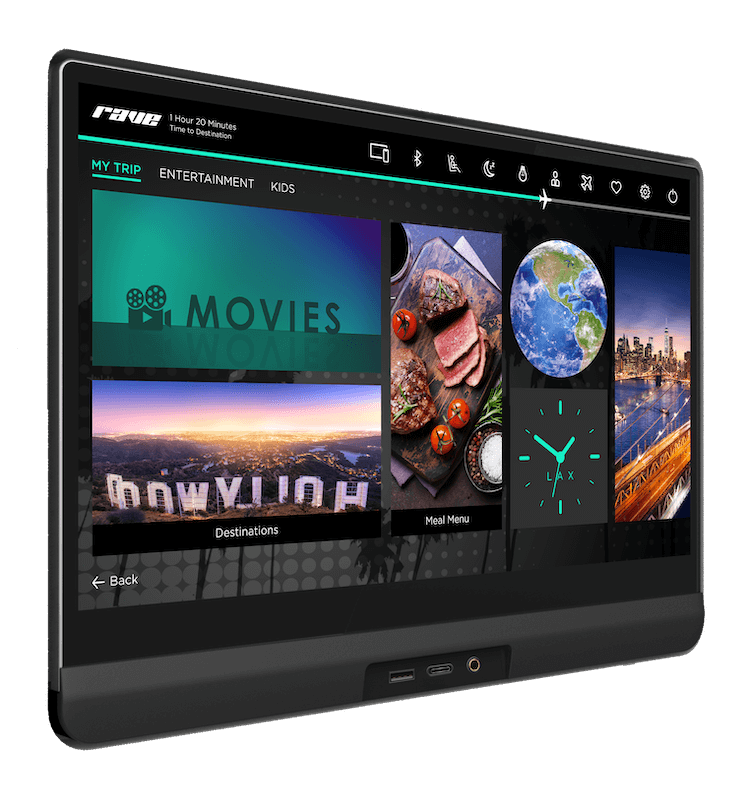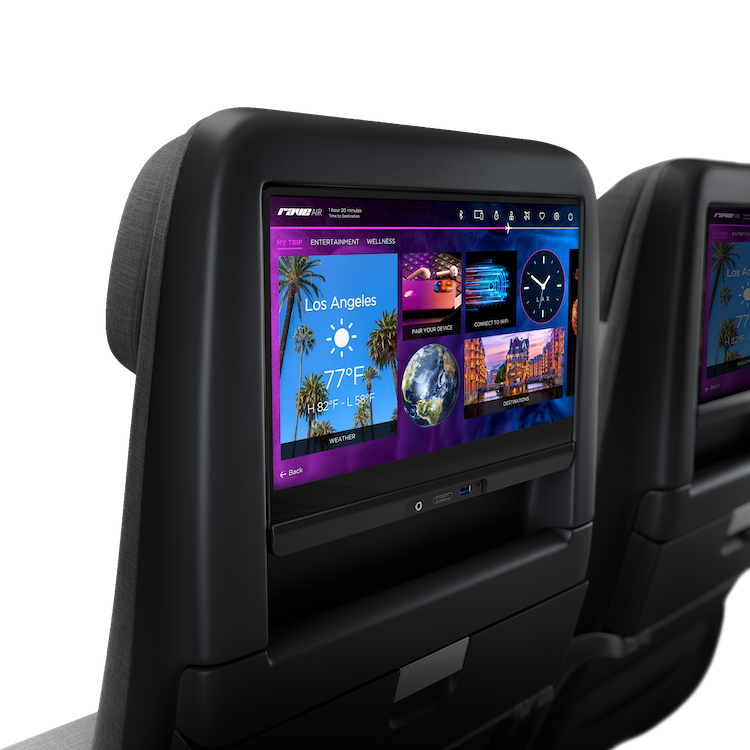The latest RAVE: Q&A with Safran's Ben Asmar
This is a special feature from PAX Tech's 2022 October APEX EXPO issue on page 12.

Ben Asmar Vice President Products and Strategy, Safran Passenger Innovations
PAX Tech: What new products or features will you showcase at this year’s APEX EXPO?
Ben Asmar, Vice President Products and Strategy, Safran Passenger Innovations: During the last two years, we have been busy updating the capabilities of our core IFEC platform RAVE OS, making it one of the most feature-rich platforms on the market. RAVE OS started flying in late 2021, and since then it has been operating on six RAVE customers and growing, and the feedback we are getting is terrific. Passengers really love it.
This is just the start. At this year’s APEX Expo, we are showcasing some of the features we will be launching in the next 12 months. This includes our third-party application platform, which allows third-party developers to create apps that can run on RAVE. This provides flexibility for our customers, allowing them to deploy new IFEC applications to their system outside of the long software development lead times and be in control of their own development.
We are also showcasing RAVE applications that have been developed using our own third-party tools, which will be deployed to customers soon. The mobile payments app allows a passenger to purchase items onboard through the IFEC system and pay for them on their own mobile device using a credit card or a payment service such as Apple Pay or Google Pay. The Advanced Survey app is a fully featured off-the-shelf survey application that we have packaged using our third-party tools to make available on RAVE. This package comes with a powerful survey authoring tool that our customers can use to make their own surveys and publish them to their entire fleet, as well as offloading survey responses that can be imported into existing customer satisfaction tools. We are excited to be able to bring these types of applications to IFEC without requiring long lead-time software development.
Another exciting feature we will be launching next year is content recommendations. While this is not a new concept, we are thinking about it differently, making it more engaging. Like most other media platforms, we will support recommendations in the movie selection menu and at the end of a movie. We will provide recommendations that are different to the current selection, guiding the passenger to content they may not have naturally selected, providing a surprise and delight moment. Our recommendation engine supports multiple modes, from metadata-matching to using our onboard AI engine, creating targeted recommendations in the same way we do for advertising.
Following an announcement earlier this year, we are excited to be bringing Sony’s award-winning 360 Reality Audio technology to RAVE IFE, in an exclusive partnership with WalkMix.com. Compatible with all connected headphones, 360 Reality Audio supports broad consumer adoption. RAVE spatial audio is the next frontier for inflight multimedia and can take a passenger from their seat and virtually transport them into the middle of a concert hall. We believe this immersive experience will be a compelling point of differentiation for RAVE customers.
PAX Tech: How are you seeing the ongoing industry recovery?
Asmar: The signs are very encouraging. This is also translating into IFEC, where we are seeing a tremendous amount of activity across most regions when it comes to new proposal requests, which is positive news for the mid-term and seems to be broadly in line with the latest recovery profile for new narrow body and wide body aircraft. Proposals for line fit are far outpacing retrofit proposals, and we anticipate that this will likely be the trend for at least the next 12 months.
 Rave OS started flying in late 2021
Rave OS started flying in late 2021
In the near term, we are starting to see some stability in the production lines of both major OEMs where aircraft deliveries are beginning to become more predictable after a series of unprecedented industry disruptions. While this is good, the challenge that most suppliers have is a reliable supply chain, so the challenge becomes meeting the demand when parts are scarce. Managing the supply chain at the micro level and daily parts allocation meetings have become the norm. So far, this careful management has allowed us to allocate parts where they are needed the most to minimize disruption to our customers. This has only been possible with closely partnering with our customers and OEMs.
PAX Tech: What IFEC features are airlines most focused on?
Asmar: It’s fair to say that just Advertising-based Video On Demand (AVOD) and a connection to the internet will not be enough as we approach the 2030s. The themes we are seeing are:
Digitization of the cabin: This is providing passengers with a personalized experience that also goes well beyond a personalized greeting at your seat. It’s about linking your airline profile with your inflight experience and allowing preferences to follow you from flight to flight, incorporating loyalty, providing targeted retail experiences and the ability for airlines to continue engaging with the passenger after their flight. This is also a key pillar of Safran Passenger Innovations’ strategy over the next three years. We have started a new product line called RAVE Digital which is devoted to inflight digital experience and helping our customers meet their goals when it comes to digitization.
Revenue generation: At Safran Passenger Innovations, we are totally rethinking how to approach IFEC revenue generation. Previous models have proven ineffective, so there is a need for something different.
We are launching this effort later this year with our new digital advertising platform, RAVE Advertising. This is not an inflight advertising solution. Rather, it’s a digital ad platform that we are using onboard an aircraft. Our vision is that seat-back screens just become another digital billboard in the digital ad ecosystem. In fact, some advertisers may not even know they are advertising onboard an aircraft. This is just step number one. Our strategy also includes digital payments, e-commerce, and digital retailing.
Environmental impact: As an industry, we have pretty lofty goals to meet in the next couple of decades and IFEC must also play its role. Airlines are looking for solutions that are lighter weight, use less power and reduce drag. This will become critically important as we start to see the next generation of aircraft being produced with significant carbon reduction targets in mind. At Safran Passenger Innovations, we have always been focused on reducing the impact of our system on the operation of the aircraft, while still providing a fully featured system. In each generation of hardware, we have removed weight and reduced power consumption and we plan to keep doing that as we design next-generation systems. We need to think differently about onboard systems and look to new technologies to reduce the number of LRUs (line-replaceable units) required, reduce cabling requirements and at the same time look at the materials we are using to ensure that our parts can be recycled, limiting the impact on our environment. It’s not just about the product, it’s about the whole lifecycle.
PAX Tech: Can you talk about any new IFE hardware you’re planning?
Asmar: Our current generation of hardware, RAVE Ultra, has been flying since the fourth quarter of last year and is being installed on more and more of our customers’ aircraft. This generation is what we will be deploying for the next few years. With our 4K dockable displays in seven sizes, we continue to bring the high reliability of our Seat Centric architecture with displays that are lighter and thinner than ever. In addition to displays, our small lightweight head-end is stocked with 16TB of storage as well as a range of power supplies to suit any scenario from 60W USB-C in every seat and AC power outlets. Our current generation hardware is available for line fit on both Boeing and Airbus aircraft.
In terms of next-generation hardware, we have started working on this, even though our current generation has only just started flying. We are working on the next two generations of hardware now. The next generation will focus on weight reduction and efficiency targeted at narrow-body aircraft, and we expect to see this coming to market in 2024.

The seat-back RAVE system from Safran Passenger Innovations offers passengers features such as Bluetooth, picture-in-picture and an intuitive user interface
PAX Tech: You are the hardware supplier for the Airbus Airspace Link HBCplus, its new flexible satellite connectivity solution. What has been the response?
Asmar: The response has been positive, and customers are interested. For HBCplus, customers will select this equipment as SFE (supplier-furnished equipment) from Airbus and Safran Passenger Innovations will then supply the equipment to Airbus for installation on the line. Although we are a supplier to Airbus in this case, we have been involved in many of the initial customer conversations.
There are two key aspects of this solution that are getting people excited. First, this SFE solution offers a streamlined connectivity solution as part of the aircraft specification. Second, the agnostic capability of the hardware means the airline can select from a number of service providers that are compatible with the hardware and then change service providers in the future with as little as new software or a change to the modman, depending on the configuration. All of the other equipment remains the same.
In addition to HBCplus, we are also offering this hardware solution for retrofit programs, allowing airlines to have a common set of hardware across their fleet. We also plan to have this solution available on Boeing line-fit aircraft.
This is a significant change to the status quo of inflight connectivity and our expectation is that this will ultimately reduce costs for airlines and further expand the deployment of connected aircraft.
PAX Tech: Are supply chain shortages impacting Safran Passenger Innovations?
Asmar: Unfortunately, I don’t think anyone has been able to escape the supply chain shortages and Safran Passenger Innovations is no different. It seems likely that we will continue to see supply chain issues well into 2023. Although I expect to see improvements throughout the year, it is unlikely we will see what we would call normal until the end of 2023 or early 2024. My hope is that as an industry we can rally and pull together and help each other as we all navigate these challenges on the path back to normal.

